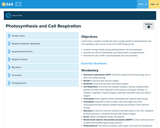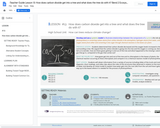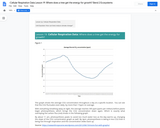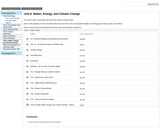
An integrated ecology unit aligned to the NCSCoS in Biology.
- Subject:
- Biology
- Science
- Material Type:
- Unit of Study
- Date Added:
- 06/11/2019

An integrated ecology unit aligned to the NCSCoS in Biology.

After completing this investigation, students should be able to: describe the biological and physical processes that make the ocean a carbon sink; describe the role of phytoplankton in maintaining the ocean biological pump- an important biological process; and use systems thinking to predict the causal effects of warmer water on the biological carbon pump

In activity Part A, students will learn how the oceans "absorb" carbon by considering two ocean processes that "pump" carbon dioxide into the oceans: the physical carbon pump and the biological carbon pump. Students will also view a PowerPoint that will show what happens to carbon once it becomes part of the ocean's biological pump.

In activity Part B, students will explore the role of phytoplankton in ocean uptake of carbon in greater depth by analyzing conditions and locations for its growth. Additionally, students will watch a NASA movie and read an accompanying NASA article about the importance of phytoplankton in the carbon cycle. Students will also view seasonal and decadal changes in phytoplankton populations using a visualization from the NASA SeaWIFS satellite program.

Students will conduct multiple experiments to test ideas about photosynthesis, including investigating plant cells under a microscope and testing photosynthesis on leaf disks in a syringe.

Stages of PhotosynthesisGiving us credit when you use our content and technology is not just important for legal reasons. When you provide attribution to CK-12 Foundation, you support the ability of our non-profit organization to make great educational experiences available to students around the world.Our Creative Commons License welcomes you to use our content and technology when you give us attribution. If you have any questions about our policies, contact us at support@ck12.org

In this lesson, students compare the basic energy transfer in photosynthesis and cell respiration, with a focus on the role of ATP. Students will experimentally determine the energy transfer between an aquatic snail and an aquatic plant such as Elodea in a test tube.

Students will investigate photosynthesis and respiration in plants. They will also apply their knowledge about these processes to the issue of deforestation in tropical forests.

Powering the Cell: Cellular RespirationGiving us credit when you use our content and technology is not just important for legal reasons. When you provide attribution to CK-12 Foundation, you support the ability of our non-profit organization to make great educational experiences available to students around the world.Our Creative Commons License welcomes you to use our content and technology when you give us attribution. If you have any questions about our policies, contact us at support@ck12.org

Students investigate photosynthesis by modeling where the atoms come from in this important process. Using LEGO bricks, students will build glucose molecules. Additionally there is a follow-up activity where the students can build both cellulose and starch from the same glucose molecules to demonstrate how glucose becomes incorporated into the roots, shoots and woods' structures of the plants we see around us.

Gases get into and out of the tree and to chloroplasts in the leaves of plants, the chemical reaction occuring at these chloroplasts and compare it to a chemical reaction model of photosynthesis.

Phloem and xylem (types of vascular tissues) will be discussed in this reading.

The uses of glucose will be discussed in the reading. During the process of photosynthesis, plants make glucose C6H12O6 in their leaves. Glucose is a simple sugar or monosaccharide that supplies a plant with chemical energy or the building blocks needed to make the organic molecules of cells.

Review the graph for respiration data.

This unit is under construction and should be ready by January 2019. Some of the materials for this unit will be taken from the former Unit 4 (Ecosystems Matter and Energy) but will also contain new material. Here is some of the source material that will be in the new unit when we get to it.

In this lesson, students use models to visualize the chemical processes of photosynthesis and cellular respiration. A handout is provided to guide students through the activity.

In this lesson, students will design an experiment to observe the products of photsynthesis in a lab setting. Students will use a model of photosynthesis to make predictions about the outcomes of manipulating the inputs for photosynthesis.